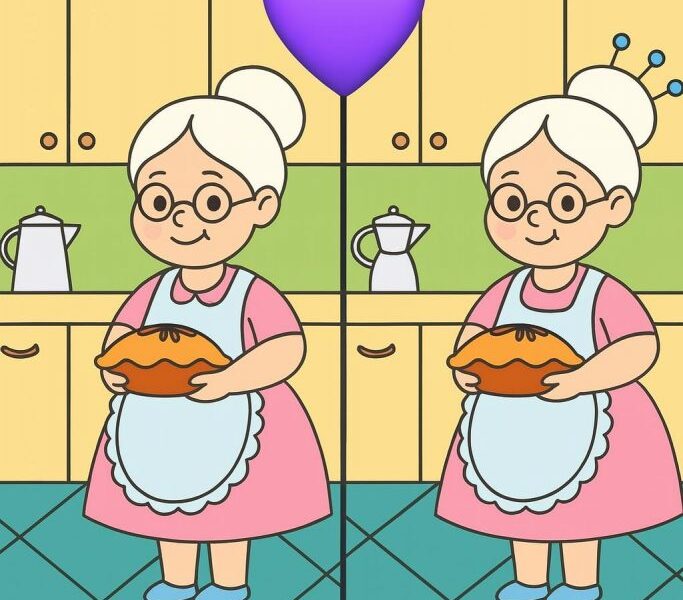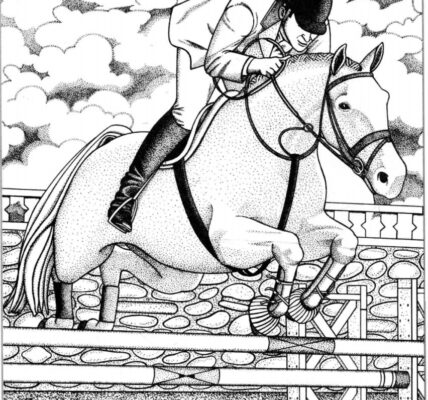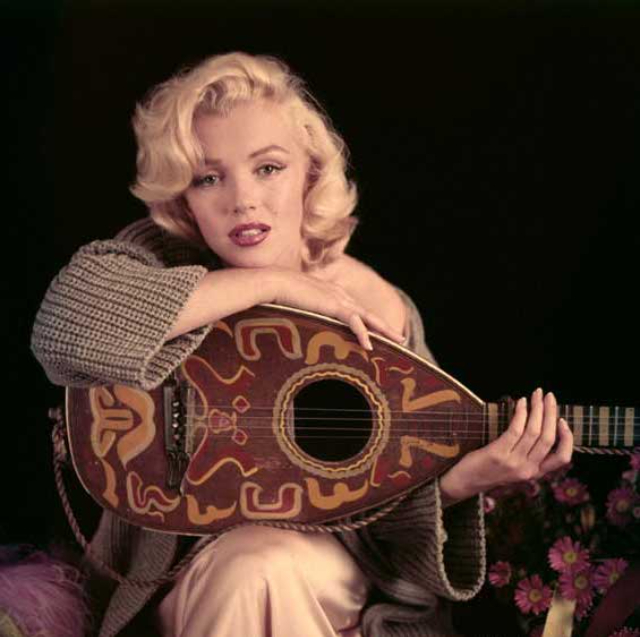Grandma’s Kitchen Puzzle: Can You Spot All the Differences?
Welcome to the Sweetest Spot-the-Difference Challenge Yet
If you’ve ever loved puzzles that make you squint, second-guess, and smile all at the same time—this delightful kitchen scene is right up your alley. Meet Grandma, the queen of warm pies and old-fashioned charm. But don’t let her sweet smile fool you—something’s off in this kitchen.
This spot-the-difference puzzle looks simple at first glance, but don’t get too comfy. Hidden within these seemingly identical illustrations are subtle, sneaky changes that’ll put your observation skills to the test.
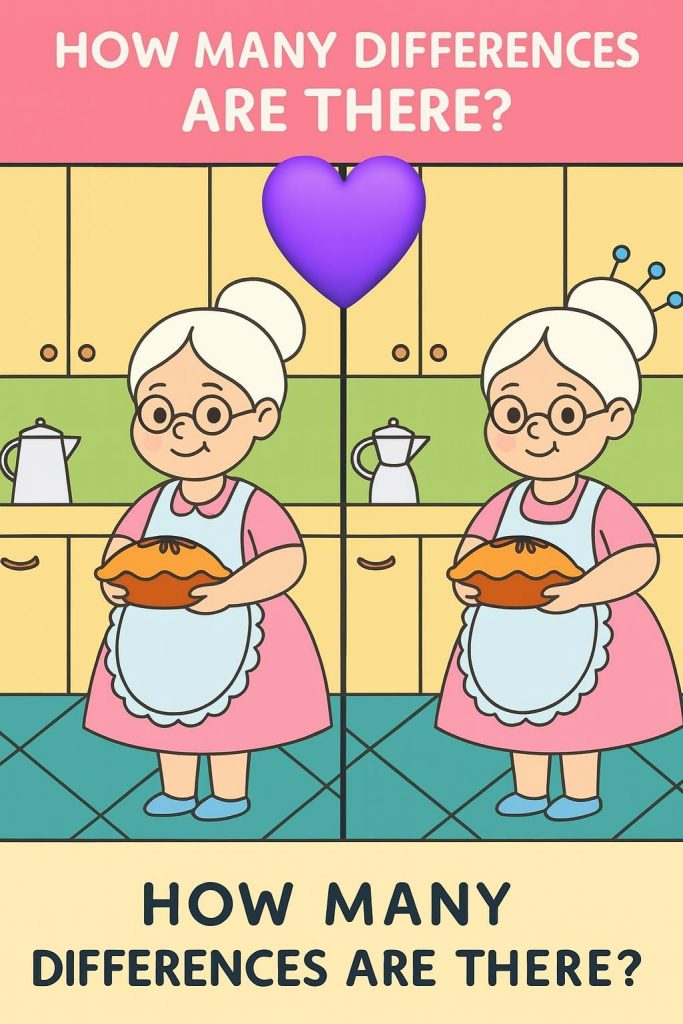
Two Grandmas, One Puzzle — What’s the Catch?
Both sides of the image show a cheerful grandma holding a pie in her cozy kitchen. She’s surrounded by the same pastel cabinets, tiled floor, and vintage coffee pots. But upon closer inspection, you’ll start to notice that these two scenes aren’t quite mirror images after all.
That’s the charm of this visual brain teaser—it hides differences in plain sight, waiting for only the sharpest eyes to catch them.
Why Spot-the-Difference Puzzles Are So Addictive
Spot-the-difference games like this one aren’t just a nostalgic pastime—they’re mini brain workouts disguised as fun. Here’s why they’re so captivating:
- They challenge our focus. You’re not just looking—you’re analyzing.
- They reward your attention to detail. Every discovery gives you a mini dopamine hit.
- They train your brain to slow down. It’s a mindfulness exercise wrapped in colorful art.
- They remind you of simpler times. Childhood activity books? Check. Lazy Sunday afternoons? Double check.

Unwrapping the Visual Clues — Here Are the Differences
Let’s dive right in. How many differences can you find between these two grandma kitchen scenes? If you’re still stuck, don’t worry—we’ve got the answers for you. Here’s what stands out:
- Hair Pins in Grandma’s Bun
On the right image, Grandma has three blue hairpins sticking out of her bun. In the left image, her bun is completely clean and pin-free. - Different Pie Designs
Look closely at the pie crusts. The one on the left has small curved slits while the right one has chocolate-like drizzle. Definitely not the same recipe! - Mismatched Cabinet Knobs
On the top-left cabinet, the knobs are missing in the right-side image. It’s subtle, but it messes with the kitchen’s symmetry. - Different Drawer Handles
Check the drawer below Grandma’s apron. On the left, it has a curved handle; on the right, it’s missing entirely. - Coffee Pot Shape Shift
The coffee pot to the left of Grandma changes shape slightly—more angular and less rounded in the right-side image. - Apron Collar Details
Grandma’s collar is fully visible in the left image, but in the right one, it’s noticeably smaller and flatter. - Apron Edge Design
Her apron on the left has straight scallops, while on the right, the design has more curved and pronounced flares. - Tile Color Difference
If you focus on the floor, the right-side tiles have darker outlines compared to the softer tones on the left. - Shoes Slightly Altered
Grandma’s slippers are identical in color, but the shape and outline around the ankle area appear sharper on the right image.
Boom. That’s nine sneaky differences right under your nose.

Your Brain Loves This Kind of Puzzle—Here’s Why
Spot-the-difference puzzles aren’t just a fun distraction—they’re surprisingly good for you. Seriously. They activate the brain’s frontal lobe, sharpening short-term memory, pattern recognition, and spatial awareness. That’s a fancy way of saying they help you think faster, remember better, and spot important stuff in everyday life.
Ever found your keys in the fridge or worn mismatched socks to work? Yeah…maybe it’s time for a few more visual puzzles.

Tips for Finding Hidden Differences Like a Pro
Want to become a spot-the-difference master? Here’s your cheat sheet:
- Split the image into zones. Start from top left and move row by row.
- Use your finger to track. It helps you focus on smaller details without jumping around.
- Check for symmetry. Human brains love balance—so when something feels “off,” it usually is.
- Zoom in (if digital). Sometimes your eyes need a little help.
- Take a break and return. Sometimes your brain needs a reset to spot what it missed.
From Grandma’s Kitchen to Your Brain’s Gym
This sweet little puzzle is more than just a picture of a grandmother baking pies. It’s a playful challenge, a nostalgia hit, and a brain booster all wrapped into one.
Each difference you spot is like solving a mini mystery—one that tickles your brain and keeps you smiling. Whether you found all nine differences or just a few, the real win is taking the time to enjoy a moment of visual discovery.
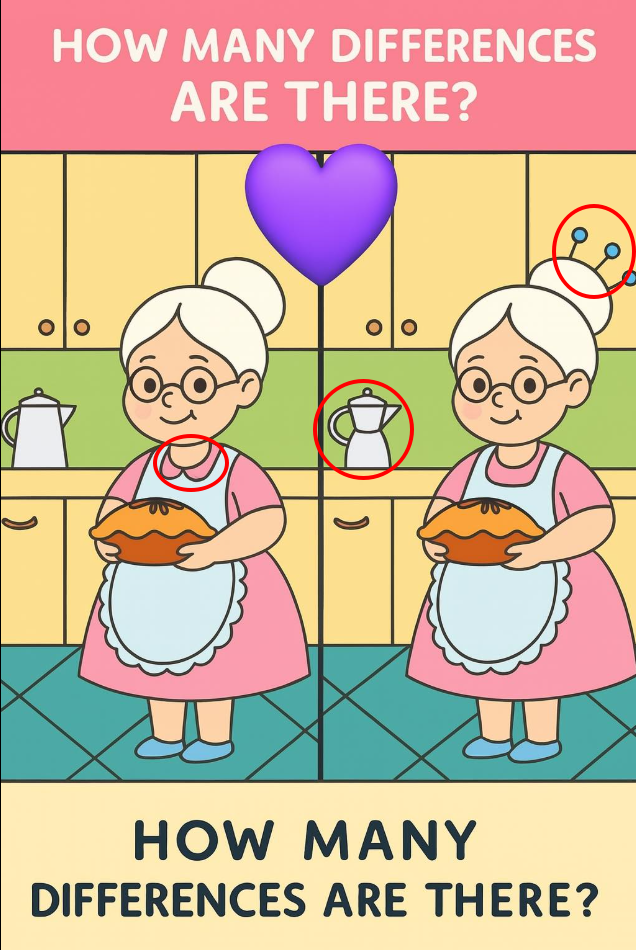
Conclusion: Don’t Underestimate the Power of a Pie and a Puzzle
In a world buzzing with distractions, a calm, quirky challenge like this does wonders for our focus. Grandma’s kitchen may look simple, but it hides a whole world of visual mischief just waiting to be uncovered.
So next time you see a spot-the-difference image, pause. Look again. And get ready to test those eagle eyes—you might surprise yourself.
